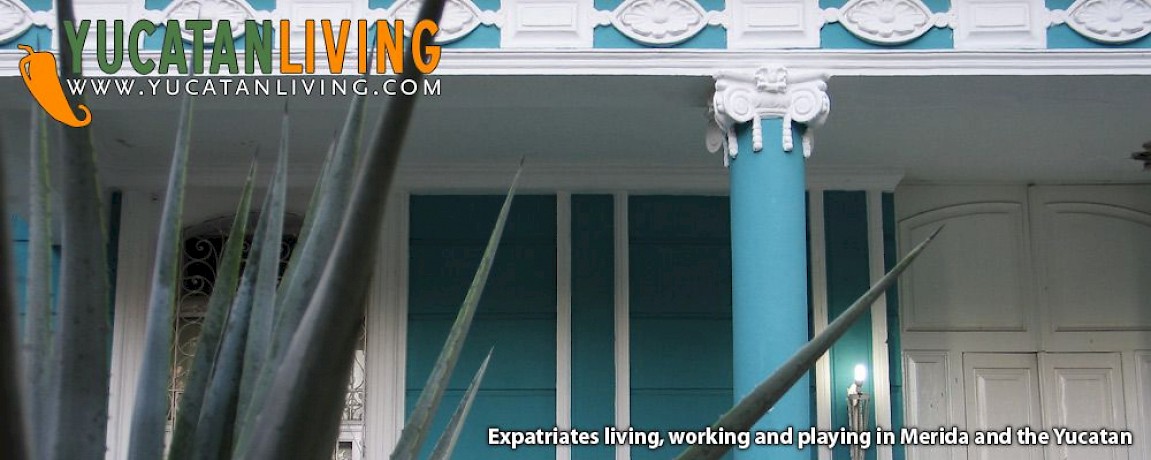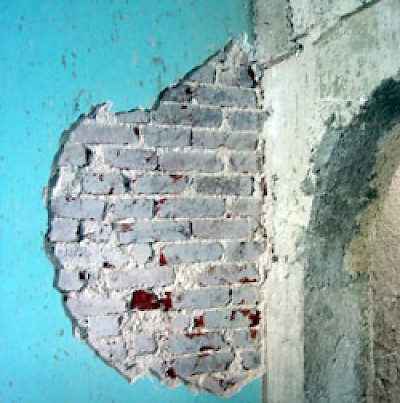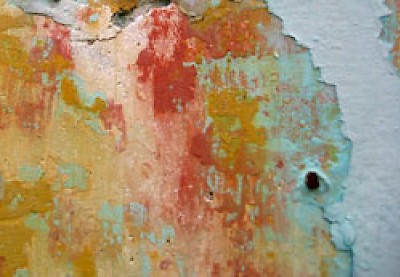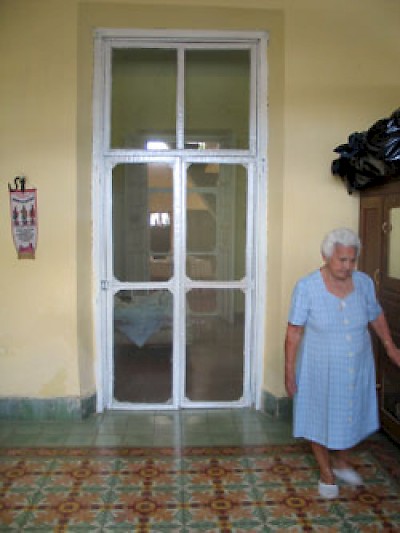Features of a Yucatan Colonial Home
Many people come to Merida to investigate and invest in the real estate market these days... what's the attraction? While there are many kinds of properties to choose from, including modern condos and beach homes, probably the most charming properties are the old colonial buildings in the historical center, with lovely European architecture, antique floor tiles and high beamed ceilings that can be renovated into truly special homes. There are old colonial buildings in many large cities in Mexico, but many of the best values are found here in Merida. Yet, before you buy that fixer-upper and begin renovating, it's good to know a little bit about the architecture here, and the process of renovation.
Typical Yucatecan homes are constructed with stone (if they are more than fifty years old) or a combination of stone and concrete block. The old stone walls, which are a combination of rough-hewn limestone and plaster are called mamposteria (mom-pos-tare-EE-uh). Most colonial homes in the historic centro of the city have mamposteria walls either as exterior walls or throughout the entire building. Concrete block walls are also common, especially with newer buildings. Houses built of red brick or tabique (tah-BEE-kay) are rare, and houses built with wood are even more scarce. There may have been more homes built of wood in the city originally, but few if any are still standing.
The roof of a colonial building, called a techo (TAY-cho), is almost always flat, and slightly sloped to provide for runoff. Originally, roofs were laid down first with heavy wooden bigas (beams), and then covered with tile and concrete. But in the 19th century, iron bigas were used. These were actually railroad track used for the small scale henequen trucks. To guard against rain and leaks, the roof is then covered with impermeabilizante (em-perm-ay-ah-beel-ay-SAN-tay), an latex-based, thick waterproof paint. This is often laid down over a layer of very thin paper or cloth for added protection. A roof needs a new layer of impermeabilizante every three or four years in the Yucatan.
Traditionally, stone or block walls are covered first with a two layers of hand-applied plaster, a rough coat and then a fine coat. For an authentic restoration, several coats of cal paint are applied. This local style of paint is mixed on site, and consists of a colored powder, white cal powder - essentially cement - and a dash of white glue as a binder, creating a paint similar to those used in frescos. It is brushed on in manos (literally "hands"), as in dos manos or two coats of paint. Because the paint is mixed locally, people find it easy to be creative with color. As as you look around the neighborhoods of Merida, you can see the results of their creativity. Cal paint will eventually show discoloration from moisture, and may eventually flake off due to excess moisture in the stone wall beneath it. Exterior walls painted with cal often need to be repainted every other year, and interior walls a little less often. You can paint with more durable types of paint, but these paints do not necessarily stick to the stone walls any better than cal in this climate. And shiny enameled walls look pretty out of place here in the Yucatan.
After the plaster and sometimes even after the paint is applied to the walls, the plomero (plumber/electrician) applies his craft. This often requires digging out channels in the stone or block walls for wiring or pipes. Electricity and plumbing were new-fangled technologies when they arrived long after the original houses had been built, so most electricians and plumbers are trained to install these amenities after the structure is completed. Most old homes will also have at least two hamaquero (hah-mah-KAY-row) installed in most rooms. These are loops of metal designed to receive hammock hooks. If your home doesn't have any, don't worry. Hamaqueros can easily be installed with a little elbow grease and cement. New ones can be found in the local mercado downtown. Older-style hamaqueros and the hooks that go in them can often be found in local antique stores or made to order.
Another common feature of colonial homes in the Yucatan are the high ceilings. Ceilings of 18 and 20 feet are not uncommon and some can be even higher. Besides giving the rooms and buildings a sense of spaciousness and grandeur, the high ceilings allow the heat of the day to rise away from the inhabitants. Combined with the thick stone walls and windows covered during the day by heavy wooden or metal doors, this serves to keep the interior of these old buildings as cool as possible when it is impossibly hot outside.
Living in the Yucatan is very much an indoor/outdoor affair. Most houses in this part of the world have both indoor courtyards (patios) and gardens in the back of the house. The jardin (har-DEEN) often has a pool that is kept empty except for when it is about to be used. Many houses fill their pools from wells drilled on the property, and pools often were not built with modern filtering equipment. So the pools were filled when they were used, and then emptied until next time. Of course, modern pool equipment is readily available now in Merida and is more commonly used in renovations.
Overhanging the patio or an outdoor terrace is a tejeban (TAY-ha-bon), a slanted roof usually built from hard-wood beams and covered with red tile. The tejeban allows you to sit outside without sitting in direct sun or rain. Older tejeban in colonial homes can sometimes still be found with the original french tiles imported here in the 19th Century.
A distinguishing feature of a Yucatecan home that everyone notices right away are the colorful tile floors. These special floor tiles, known as pasta or mosaicos (mo-ZAHY-koz), are made here from concrete, colored powder and hydraulic pressure. They are laid down with a matte finish and polished in place after installation. You can read more about these tiles in our feature story about floors. The tiles can be chosen from existing colors and designs, or you can pay to have a mold created in a design of your choice. Either way, the result is a stunning floor for a reasonable price. If you are lucky enough to find an old colonial home with original floors, do not despair if the floor looks ugly and worn. Most of the time, these tiles can be repolished and will look as good as new.
Many old buildings still have original stenciled designs painted on the walls. Some of these are painted to resemble wall paper that would have peeled off in less than a season of tropical weather. Painting these is a skill that is still available here from local artists, so new designs can be painted on your walls, or old ones can be copied and renovated.
Houses in the Yucatan have very few windows. Most openings between interior and exterior spaces are doors. These doors usually have smaller doors inserted into them, above a typical person's sight-line, so that the small door can be opened for fresh air without giving up privacy. Original hardwood doors in old colonial homes are very valuable and can be refinished to be restored to their original beauty. A skylight, or tragaluz (TRAH-gah-loos), is easy to install in a ceiling and is another solutions for getting light into a dark interior room.
An original Yucatecan kitchen is often just open concrete shelves, sometimes covered with or edged with fired tiles. In this humid climate, before there was air conditioning (and even now, if you don't want to be running your air conditioners all day and night), it was best to leave shelves open so that air can circulate.
These are just some of the more obvious elements of a typical colonial home in the Yucatan. In our next article, we'll go under the surface to look at the typical plumbing and electrical solutions in this part of the world. We've been here for over four years now, and seen a lot of homes built or renovated. We've learned that often the building habits that did not originally make sense to us have developed for a reason. And it is best to learn how things are done here, and learn the reason why they are done this way, before you try to change things. More often than not, we've concluded that the great innovation we had in mind just didn't work in the tropics or with the chosen materials. Local craftsmen have been building houses here for over four centuries. The most successful renovations are informed by their history and traditions.













Comments
CasiYucateco 16 years ago
Well, I don't have any data on it, but I imagine the freer flow of air through the thatched roof and the sides of the wooden stake structure would be much more comfortable than the horrible black tar-paper roofs. They are cheap, but whew! Black tar paper (referred to as "carton" or "lamina" in Spanish) gets really hot in the tropical sun. And a nice petrochemical smell too.
A while back someone from a US university was doing heat island or city environment studies (effect of plants and trees on city temperatures?). Does anyone remember who / where that was? At least one of their studies was specifically on different neighborhoods of Merida. The more plants, the lower the warming.
Reply
david bainbrigde 16 years ago
Thanks for the very nice description. I am looking for a comparison of thermal performance of the old Yucatec Maya round ended limestone/thatch roof vs modern concrete block with the the black corrugated roof. Any suggestions? Anyone interested?
Excellent paper on old Havana explores what makes these colonial designs work. Tablada et al 2009 in Building and Environment.
Reply
CasiYucateco 17 years ago
Dave, this is just my own personal opinion: Do not use wood. Avoid wood wherever possible, admitting that some nice wooden doors really make a house. Wood in the tropics needs constant maintenance. There is no wood that is 100% free of various bugs, whether they are termites or not or just plain old rot.
And, even if they don't rot, they will hold moisture, making the room more humid.
We just went through this with a friend who really loves wood floors. He put in wood floors in Merida. A few roof leaks (a little water, not a lot) and bugs later, and the floors were all torn out. Rotted and eaten. And they were "madera duro" "tipo Brasil." Thousands of dollars... They were not soft wood. Finished, sealed and still rotted and eaten. So, just sayin'....
Properly built block walls will have a stone foundation to above ground level, then have a water-proofing coat of something like tar (probably is tar) and then the blocks are built on top. The cement blocks (and stone foundation, if it shows) are covered with a stucco layer of cement.
That type of wall would hold paint well (if you use two coats of cement sealer (sellador) on it). I'm assuming since you don't want flaking, that you also do not want the traditional higher up-keep cal paint. A good paint like Comex or Berryl will stay pretty decent for a while.
Reply
Dave 17 years ago
My house is perhaps 70 years old, and has no period details.
Does anyone know, please, if it is practical to build wooden interior walls
so as to avoid dealing with constantly flaking maposteria? Of course I
would not use wood that would attract termites. Thanks.
Reply
Dave 17 years ago
Thanks for taking time to share your experience, info and pics with us !
Reply
Yucatan Living - Building Our House - VIII - The End 17 years ago
[...] to Build a House in the Yucatan Features of a Colonial Home How to Sell Your Home in Merida Tips for Purchasing a Colonial [...]
Reply
Amy 17 years ago
Wow, this site offers so much useful info for a Merida "newbie". I've traveled around the Yucatan for a decade, and have lived in Rio Lagartos and Tizimin, but circumstnaces force me to now live in the big city. I'm not too fond of big cities, but I always liked Merida, just never figured on living here. Now, I'm experiencing a sensation of excitement over the possibilities, and a growing fascination with Colonial architecture- hey, maybe some day I can do this!
Reply
CasiYucateco 17 years ago
Thanks that's very interesting. I'm sure there are many people who have various opinions about materials in Merida or Yucatan, but experienced, knowledgeable local architects would know best. And that's who you used.
Some of us have been following the Working Gringos website so long, it has started to go beyond our ability to remember all the great details provided in the articles (or my mind is starting to go, but I prefer the former explanation). I'm going to see about having my walls plastered. The original walls (that are still there) were painted cement or mamposteria. The newer ones aren't finished yet. At least a few rooms deserve the rich appearance that your builders achieved.
Reply
Working Gringos 17 years ago
CasiYucateco,
The most common finish on the walls of the colonial homes in Merida is lime-based stucco, derived from limestone, which we have here in abundance. Since this material has been used for centuries, we'd say it's the "real" plaster. In many cases, it is painted with lime wash paint, called "cal" in Yucatan. This is also a lime stucco, but much more watered down and with pigment added. Other versions of lime stucco we used include chicum (adds tree bark) and kankab (adds red earth), both are authentic Maya finishes frequently used on the local haciendas.
The plastering process used here is described in Building Our House V. More details about acabados (finishes) can be found in the Building Our House VI article.
Reply
CasiYucateco 17 years ago
Hello Working Gringos!
I have read this article again, well, for about the 3rd time now. I actually was hunting to see if you had a "final" article on building your house and moving in. All of these "features" and "building" are outstanding descriptions of the processes, of the considerations, of the materials and methods used in Merida homes.
I have a question. Your new home walls are beautiful. No, they are gorgeous. Just a finish far above what I've seen elsewhere (particularly in my humble abode). Above, you write about the walls being "plastered."
Are you talking about real plaster - gypsum-based plaster as we think of it in the USA? Or are you referring to plastering cement on the walls in thin coats, as though it were plaster?
I have a couple reasons for asking, but the main is that your walls are just so wonderful. Usually, or often, I have heard it said in Merida that "plaster won't work" with the humidity. Or that the only material to use is a hard cement finish, often with vinyl or acrylic based paints.
So, if you don't mind sharing your secret to the world's most wonderful walls, are they real plaster? With color mixed into the plaster itself? Or painted on later with the plaster-like cal paints? Cuz, you know, envious and inquiring minds want to know (how to make something in my house better looking)....
And, thank you so much for the absolutely over the top (due to vertigo)* tour of your home! A very welcome break on a very hot construction blitz at my place.
* just kidding, mostly! ;-)
Reply
Working Gringos 17 years ago
Greg,
Building our new house in a colonial style has cost us about $45 USD per square foot, but we are working through an architect with professional work crews, paying social security, add all the modern ammenities, using best practices, etc. You can build for less than we paid if you supervise the project yourself and minimize on luxuries.
When doing a restoration, so much depends on the condition of the existing structure and how far you want to go with modern upgrades that it's difficult to predict a price per square foot in any general way.
Most people here say it costs more to restore than to build new, but that also depends on how much restoration is required or wanted. One of the easiest (and least expensive) projects we've done was restoring a small, two-bedroom colonial in the centro that we currently use as an office. The structure was fundamentally sound, our goals were modest and there were no "surprises".
It's the surprises and embellishments that usually drive up the cost.
Reply
(0 to 11 comments)Next »